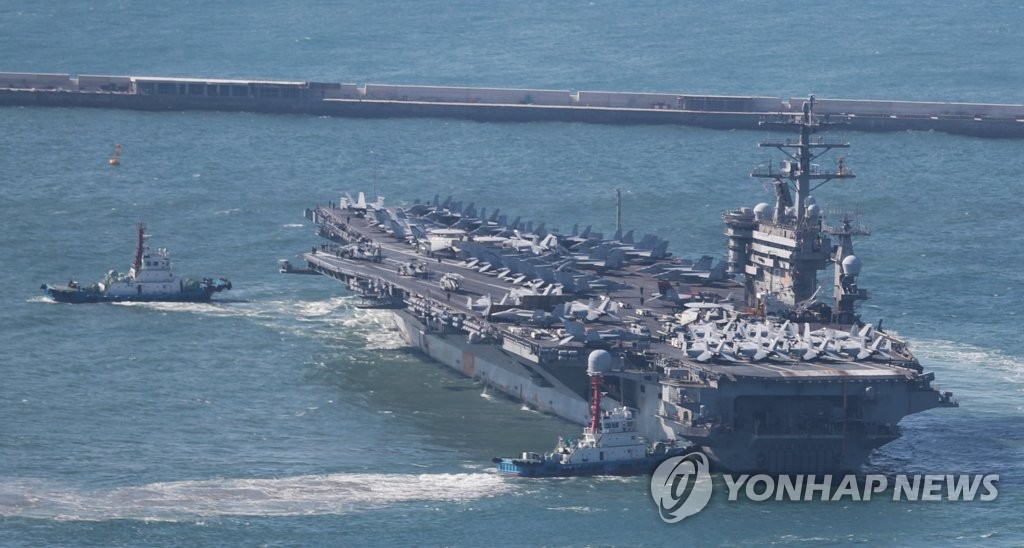- California Assembly OKs highest minimum wage in nation
- S. Korea unveils first graphic cigarette warnings
- US joins with South Korea, Japan in bid to deter North Korea
- LPGA golfer Chun In-gee finally back in action
- S. Korea won’t be top seed in final World Cup qualification round
- US men’s soccer misses 2nd straight Olympics
- US back on track in qualifying with 4-0 win over Guatemala
- High-intensity workout injuries spawn cottage industry
- CDC expands range of Zika mosquitoes into parts of Northeast
- Who knew? ‘The Walking Dead’ is helping families connect
S. Korea, U.S. to form nuclear consultative body amid N. Korea’s growing threats
- South Korean President Yoon Suk Yeol and U.S. President Joe Biden will issue a joint statement, called the Washington Declaration, under which the allies will establish a joint nuclear consultative body as a way of strengthening Washington’s extended deterrence provided to Seoul, U.S. officials said.
A senior U.S. administration official, who spoke on condition of anonymity, said the allies will form a new “Nuclear Consultative Group,” which is modeled after the NATO Nuclear Planning Group and will provide South Korea “additional insight” into how the United States plans and prepares for major contingencies.
Also, the U.S. will more regularly deploy strategic assets to South Korea to counter North Korea’s rapidly developing nuclear and missile programs, the official said.
“We will announce that we intend to take steps to make our deterrence more visible through the regular deployment of strategic assets, including a U.S. nuclear ballistic submarine (SSBN) visit to South Korea, which has not happened since the early 1980s,” the senior administration official said in a telephonic press briefing Tuesday.
Seoul, in return, will reaffirm its commitment to the Nuclear Non-Proliferation Treaty, according to the officials.
U.S. National Security Adviser Jake Sullivan earlier said the leaders will issue a statement on U.S. extended deterrence when they meet here this week. Yoon is currently on a state visit to the U.S. He and Biden are set to hold a bilateral summit later in the day.
“We will strengthen our training, our exercises and simulation activities to improve the U.S.-ROK alliance’s approach to deterring and defending against DPRK threats, including by better integrating ROK conventional assets into our strategic plan,” the official said of the envisioned Washington Declaration.
ROK stands for the Republic of Korea, South Korea’s official name. DPRK refers to North Korea’s formal name, the Democratic People’s Republic of Korea.
The declaration, expected to be issued by the leaders later in the day, follows an unprecedented nuclear and missile provocation by North Korea.
Pyongyang fired a record 69 ballistic missiles in 2022 alone and has already launched dozens of missiles since the start of this year, including an intercontinental ballistic missile (ICBM) that top U.S. military leaders have said may be capable of reaching Washington, D.C.
“I would simply say that what we’ve seen over a period of years are persistent, worrying missile tests, nuclear saber-rattling, public threats that are designed to send an ominous signal to South Korea and the surrounding region,” the U.S. administration official told the telephonic press briefing.
“We have urged North Korea to return to dialogue and discussion. They have chosen not to and instead have taken a series of increasingly provocative and destabilizing steps. We believe that our approach is prudent. It is in response to those provocations,” the official added.
It is also designed to help reassure South Koreans of U.S. commitment to the security of South Korea, the official noted, as the calls to strengthen U.S. extended deterrence also follows a recent debate over whether Seoul should arm itself with its own nuclear weapons in the face of North Korea’s evolving nuclear threats.
The Washington Declaration, while calling on Washington to more effectively and reassuringly show its commitment to the defense of South Korea, asks Seoul to reaffirm its non-proliferation commitment, according to the U.S. official.
“The ROK will reaffirm its enduring commitment to its own obligations under the Nuclear Non-Proliferation Treaty,” the official said.

Another administration official, who also spoke on condition of anonymity, stressed that the declaration will not lead to any deployment or stationing of U.S. nuclear assets in South Korea.
“I will be crystal clear. There is no vision of returning U.S. tactical or any other kind of nuclear weapon to the Korean Peninsula as there was in the Cold War,” the official said.
“When we talk about more frequent cadence of the deployment of strategic assets, what we mean is visit, such as … this SSBN visit to the ROK. We mean occasional, very clear demonstrations of the strength of our extended deterrence. But we do not mean any permanent or stationing of additional assets and certainly not any nuclear assets under this framework,” the official added.
The second administration official also made it clear that the declaration is, at least partly, aimed at reassuring the Korean people of the U.S. commitment to the defense of South Korea.
“While we absolutely believe that our declaratory policy is everything that we need, is as strong as it needs to be, we also believe that it’s understandable that some of the Korean people would have some anxiety about living under Kim Jong-un’s nuclear shadow and would raise questions about what U.S. extended deterrence means and how it’s going to work if it ever becomes necessary for the Korean people,” the official noted, referring to North Korea’s leader.
“So the mechanisms of consultation and the exercises that we will be unveiling tomorrow are really intended to build that confidence by not only the Korean government but the Korean people in this alliance, which we have long known to be strong, that have remained strong and will remain strong for many years to come.”











